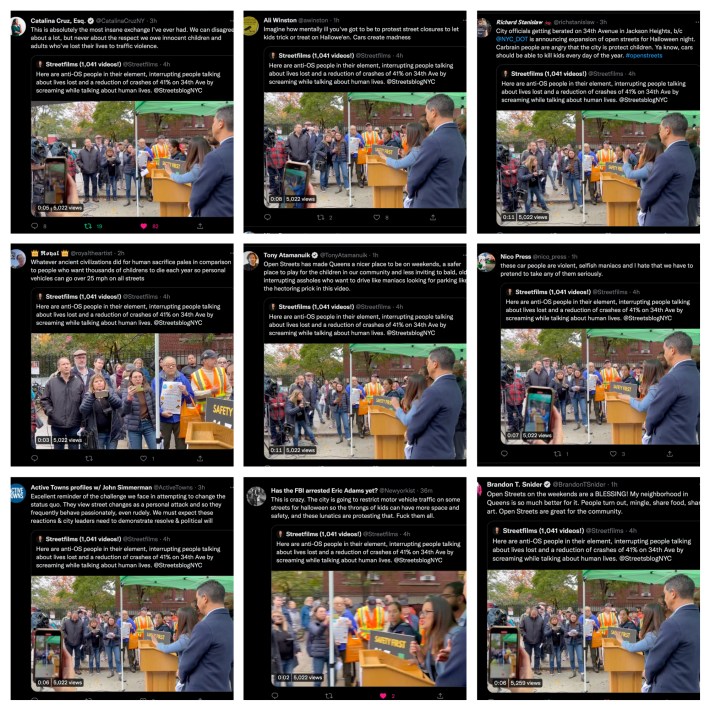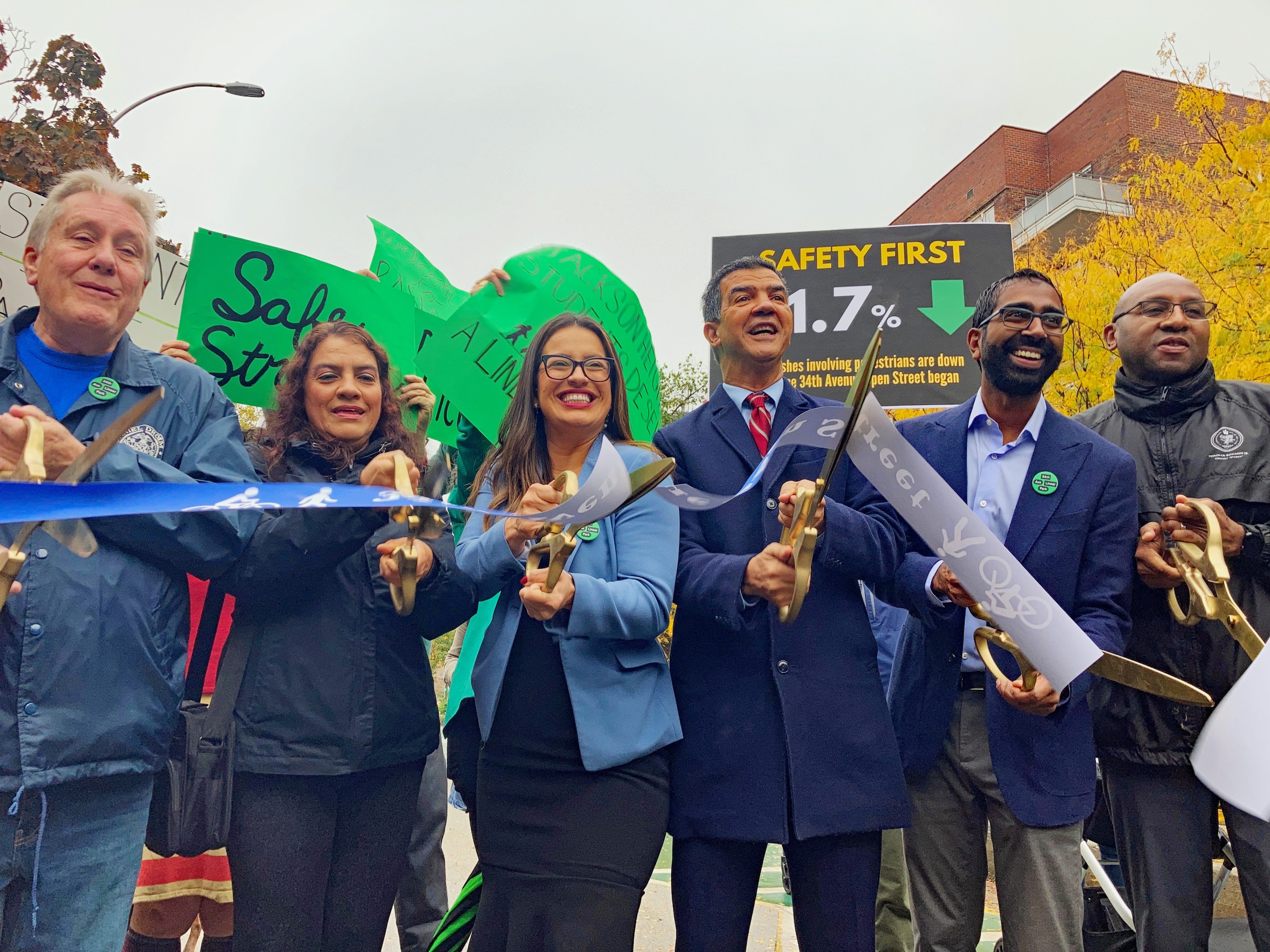Department of Transportation Commissioner Ydanis Rodriguez cut a ceremonial ribbon on the 34th Avenue Open Street on Monday, but the two-year project, now called “Paseo Park,” is already an overwhelming success: the street has become much safer for all users as it has created dignified public space for all residents.
City officials are now poised to make permanent changes to 34th Avenue. They should build on success and recognize what is going right.
Long story short: not only are the 1.2 miles between Junction Boulevard and 69th Street much safer, so is the surrounding area. This has happened even as thousands of people use the street every day for transportation, relaxation, exercise, and even as a place to work and study. All of this has been carved out of a street that was pretty, but dangerous.
Traffic deaths are the most striking change. Even as the streets are crowded with walkers and bikers, little kids and old people, skaters and lollygaggers, nobody has been struck and killed on 34th Ave. in the last two years. That can’t be taken for granted. Car drivers killed people on this street in August 2013, May 2016, and August 2016, when the number of people walking and biking was far lower.
SIDEBAR: DOT TOUTS SAFETY IMPROVEMENTS ON 'PASEO PARK' AS FOES RANT
Some claim that traffic violence has just been displaced to adjacent streets. But that's not the case, according to a decade of city crash data, which is mapped on the website Crashmapper.
In the whole square-mile area from north of 32nd Avenue to south of 37th Avenue and from Junction Boulevard to the BQE, car drivers killed 14 people between October 2012 and September 2020 — just before the open street became permanent. That's 14 families damaged forever.
In the last two years, there hasn't been a single traffic death in this area. That’s the longest streak for this area to go without a road fatality since at least 2011, when Crashmapper records begin.
And let's not forget to consider all crashes, even those without injuries. Between October 2012 and September 2020, there was an average of 90 crashes every month in the square mile area. Since September 2020, that number has dropped to 51 per month, a decline of 43 percent.
(Not everyone believes it, of course, which forces supporters to continually debunk the mistruths, as the photo montage below shows.)

The design improvements have helped the broader neighborhood to outperform on safety. Across Queens Community Board 3, eight people were killed by traffic in the two years from October 2018 and September 2020. In the last two years, that number fell by 75 percent, to two deaths. That is a far bigger decline than most of Queens. Borough-wide, traffic deaths fell by only 25 percent in the same period. On Paseo Park, we are doing much better than most of Queens.
Another striking number is injuries along 34th Avenue itself. The number of people injured in Paseo Park has plummeted. Prior to its transformation, this stretch of the avenue experienced an average of 65 traffic injuries per year. That number is now down by almost half, to 36 per year.
Pedestrians are the most vulnerable people on the street. City data shows that 19 pedestrians were injured on 34th Avenue in its first two years. That's 19 too many, of course, but it’s also a big reduction from 27 in the prior two years — and this reduction took place while the number of people walking on the street multiplied.
The improvement in bicyclist safety is even more impressive. Again, far more people — including lots of small children — ride bikes on the open street today than did when it was a mixed-traffic avenue. As the numbers have grown, injuries have plummeted.
Prior to the pandemic, what’s now Paseo Park was a major source of injury for cyclists. For all the thousands of miles of roadway in Queens, there were several years when this little segment was the site of one in every 50 cyclist injuries in the borough. Cyclists would come because the street seemed better than nearby alternatives, only to end up in an ambulance.
Today, the number of cyclists injured on this stretch has fallen by more than half. This is remarkable, as cyclist injuries in Queens as a whole have barely budged (down just 3 percent). In the broader area of 32nd Avenue through 37th Avenue, the decline has been less significant (declining 7.5 percent), showing there is still work to do.
Paseo Park is a social justice victory as well as a safety win. About 7,000 students attend school along the avenue, the vast majority kids of color. The surrounding neighborhood is diverse, with $3-million single-family homes adjacent to overcrowded apartment buildings. This park has for the first time given everyone in the neighborhood a dignified, safe place to enjoy fresh air, get some exercise, and share space.
There is a spot of bad news. Over the past year, motorist injuries have risen to near pre-2020 numbers in the area from 32nd Avenue to 37th Avenue. And even 34th Avenue itself remains imperfect. At the corner of 106th Street, 10 blocks from Paseo Park, a motorist was killed in a crash in September, according to Crashmapper. The ongoing epidemic of traffic violence shows the importance of extending open streets beyond this one segment. Paseo Park should go all the way through Corona to Flushing Meadows Corona Park. Unfortunately, it now ends abruptly at the border of City Council District 21, where Council Member Francisco Moya has, thus far, failed to support such a project.
To be sure, the changes in the neighborhood since fall 2020 aren’t all a result of the open street. The city has made intersections safer on Northern Boulevard as well. And traffic patterns are different now from before the pandemic, adding uncertainty to these before-and-after comparisons. But looking at the numbers, it certainly appears that the open street has been a success.
The improvements we’ve seen on 34th Avenue should be held up as an example. We have eliminated road deaths and slashed injuries, while providing much-needed open space. We need more streets like this, in more neighborhoods. We should have a full network of open streets and linear parks, so people of all ages and abilities can traverse the city on foot and bike. Here’s to more Paseo Parks.
Steven Bodzin is a founding member of Friends of 34th Avenue Linear Park. He lives on 34th Avenue in Jackson Heights.






